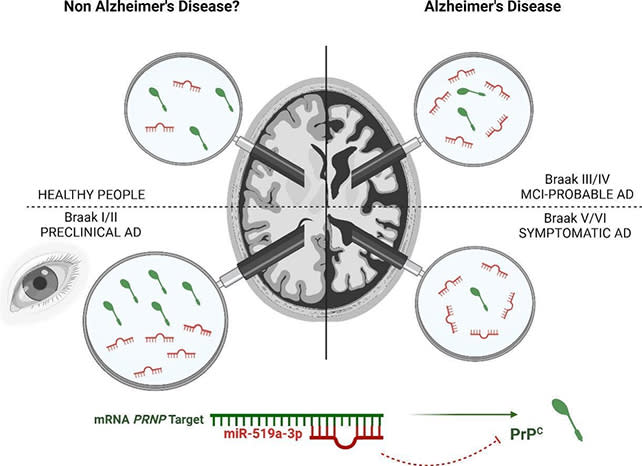This New Clue May Signal Alzheimer's Before You Have Symptoms
While we don't yet have a cure for Alzheimer's, a newly discovered biomarker may indicate the disease before symptoms appear – which means mitigating treatments can be put in place, and researchers can look more closely at how the condition develops.
The biomarker in question is a molecule of microRNA called miR-519a-3p, and the team behind its discovery thinks it could give us a vital early warning system for Alzheimer's.
Led by researchers from the Institute for Bioengineering of Catalonia (IBEC) and the University of Barcelona in Spain, the study detailing the biomarker findings explains how higher levels of miR-519a-3p are found in people with Alzheimer's.
"Currently, tests to diagnose Alzheimer's disease are usually carried out after the onset of symptoms, when there is already underlying cognitive impairment," says neuroscientist José Antonio del Río from IBEC.
"We believe that the detection of this microRNA may help to establish additional criteria for a more accurate diagnosis in the early stages of the disease."

MicroRNAs such as miR-519a-3p are small non-coding RNA molecules, genetic materials that help cells manage protein production.
These microRNAs tend to be stable in the body and are easily detectable in bodily fluids, making them very useful as biomarkers to warn of disease, measure response to treatments, or capture general health status.
This miR-519a-3p molecule is linked to the production of cellular prion protein (PrPC), which is already known to be more abundant in the body in the early stages of Alzheimer's, while its levels decrease as the disease progresses.
The researchers used brain tissue taken from people with Alzheimer's after their death, together with chemical tests, to establish that miR-519a-3p promotes decreased production of PrPC.

The team found higher levels of miR-519a-3p in brain tissue from early stages of Alzheimer's. Lab experiments showed that this molecule binds to a region of the gene that controls expression of PrPC, decreasing how much of the protein is produced as the disease progresses.
It's not definitive proof yet that this biomarker is an early warning sign for Alzheimer's – but it's strong evidence that it could be.
"If our goal is to use miR-519a-3p as a biomarker to detect Alzheimer's dementia in hypothetically healthy people, it is essential to ensure that its levels are not altered in other neurodegenerative diseases," says neuroscientist Rosalina Gavín from IBEC.
"In our study, we compared the levels of this biomarker in samples from other tauopathies and Parkinson's disease, confirming that the changes in miR-519a-3p are specific to Alzheimer's disease."
The study advances our understanding in several areas, including the mechanism through which PrPC decreases as Alzheimer's progresses, and how that mechanism might be used to detect the disease before signs of dementia.
It's one of several potential early indicators that scientists have found in recent years, and further down the line it may be possible to combine several of them to create a simple, surefire way of detecting Alzheimer's as early as possible.
"The next step is to validate miR-519a-3p as a biomarker in blood samples from different cohorts of patients, in order to start using it in the clinical diagnosis of Alzheimer's disease in peripheral samples," says neuroscientist Dayaneth Jácome from IBEC.
The research has been published in Biochimica et Biophysica Acta (BBA) - Molecular Basis of Disease.

